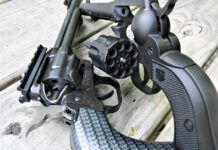Cowboy Action shooters might well consider choosing a .38 Special for their activities if they have even the slightest trouble with recoil from the .45s. Recoil recovery plays a big part in Cowboy competition, speed being mighty important for best scores. We tested a few other .38 Special/.357 Magnum single actions recently, and here we have two more. These are the American Western Arms Ultimate 1873, all blued, for $600, and the Charles Daly 1873 Standard Model, $460. Both have 5.5-inch barrels, and both are made by Pietta in Italy. There are similarities, but the differences are plain to see. Here’s what we found.
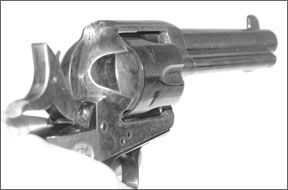
American Western Arms Ultimate 1873, $600
On all versions of this single action, the frame is forged and the barrel is hammer forged. Options include a variety of chamberings, and either nickel or hard-chrome finish for $195 over the base price. There is also a Bisley version in .45 or .357. The Classic version uses a traditional flat hammer spring and costs only $440 in all-blue, or $565 with real case hardening. Our Ultimate had a coil hammer spring. More on it later.
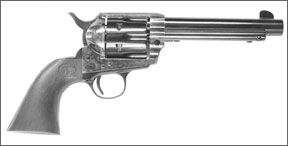
Metal polishing on our gun was excellent, giving a glossy look to the bluing. The gun was made in Italy by Pietta, a company which has pleased our test staff with other importer’s guns. The AWA had its model name on the barrel. Good luck trying to read it in normal light, but that’s all good if you want your AWA to look like a cowboy gun, not one with all sorts of useless information embarrassingly embossed into the barrel, as found on some other prominent-make sixguns.
Workmanship was excellent throughout, we thought. All the controls were very Colt-like. The construction of the AWA was entirely as was done on early Colts, even to the full-length cylinder-pin bushing, the beveling on the fronts of the chambers, and the curved-bottom trigger guard. This gun was in fact set up to be just like early revolvers, load only five shotsunless you’re in a gunfight and keep the hammer down on the empty chamber. The hammer held the loosely fitted firing pin via a cross pin, just like in days of old.
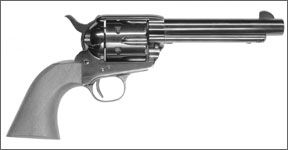
The gun was fitted with decent one-piece walnut grips. The inletting was exemplary, but the wood finish was dull and lackluster. A good rubbing with linseed oil would help, we thought. However, the rear edges of the wood were much too sharp. The sharp edge stung the hands with hot loads. Sandpaper would fix this. The Daly also had this flaw.
In our examination of this six-shooter we found an odd situation. If the hammer was cocked with the cylinder out of the frame, the hammer could not be lowered unless you knew the trick. The trick is to press the cylinder hand rearward, and then the hammer can be lowered. The Daly had the same setup.
The only fault we could find on this gun with its mechanism was one shared by many an old Colt: the cylinder-release button unscrewed and fell out of the frame. We found all three parts and put it back together. A touch of Loctite would fix this, but the maker needs to do it, we feel, not the owner. We lucked out that the parts, including the tiny spring, fell out in our office and not in the field. This is something every owner of a single-action Colt or any of its clones needs to be aware of. But even if you do lose all the parts the gun will still fire, one of the beauties of the old Colt design.
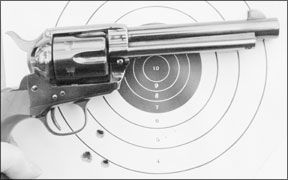
The action on this revolver was noticeably light and slick, so we went looking to find out why. Three screws, just like on old Colts, got the rear grip strap off, and we found a simple but very effective coil-spring setup inside the Ultimate 1873. The feel of the hammer was extremely slick, not quite the feel of old Colts with their leaf spring, but we liked this setup. While the coil hammer spring adds to the cost, serious competitors might find it worth while.
On the range we found another minor problem, though it was not accuracy, which was mostly fine with our test ammunition. We tested with Black Hills cowboy loads, a similar handload, Federal Hi-Shok 125-grain JHP .357 Magnum, and with Winchester SXT .38 Special 130-grain JHP. With cowboy-level loads our hits at 15 yards were about 2 inches low and 3 inches left. With the hot .357 ammo, the strike was worse, 4 inches low and 6 inches left. Accuracy with the .357 fodder was not good, and the blowby and blast were so bad that we discontinued our testing with it. There is no reason to test ammo that is useless, we figured, and if you can’t get close enough to where you’re aiming, the ammo/gun combination is useless.
The off-center hits would be a big problem for some, but other shooters would feel that windage misalignment would be normal for general cowboy-action shooting. The low strikes would not be much of a problem. The front sight presented a round-topped post to the shooter, which could be filed flat to give a better picture and raise the impact. The rear sight was a U-shaped notch of good width. But there’s no easy way to get the hits in line with the center of the target.
Charles Daly 1873 Standard Model, $479
The finish looked great, we thought. The bluing was very well done on nicely polished parts. The one-piece walnut grips’ dark finish was complemented by an incised and tasteful “CD” at the top. The fit of the wood to the steel was excellent. The wood was too sharp at the bottom, as was the case with the AWA. The cylinder had the appropriate bevels at its front end, and had the full-length, base-pin bushing insert common to early Colts. The trigger guard had the turn-of-century rounding that most of us prefer. The action was mighty slick, the hammer feeling quite smooth, though not as light as the AWA’s.
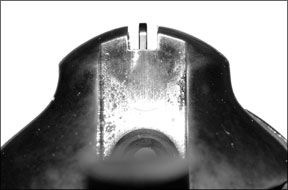
The barrel bore the Charles Daly name and the caliber markings on its left side. Neither the barrel nor the frame had any of the usually seen Colt date stamps or address markings. The gun looked and felt like a Colt, despite the absence of the markings. However, the cylinder did not quite interchange with that of a genuine old Colt. The front sight was way too high, as we found on the range, but that’s always better than being too short. The sight picture was better than the AWA’s, with a slightly wider and cleaner rear notch, and a flat top to the front sight.
Daly offers several options, but in only two calibers, .45 LC and .38/.357 Mag. There is a stainless version with pseudo-ivory grips and with your choice of three barrel lengths, 4.8, 5.5, or 7.5 inches. There’s a brass-handled version in three lengths, but .45 only, at $450. There are three blued & case-colored versions, like our test gun, in each of 45 and .38/.357 at $479 each, and six stainless versions, each of which will set you back $630. From the images posted on the company website, the brass grips do not quite have the correct contours.
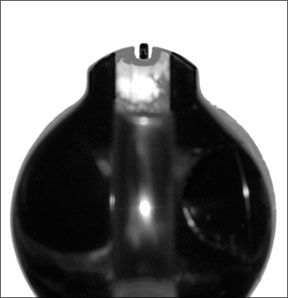
One thing we didn’t much care for was the base pin. It had two notches cut into it that had to be lined up so they were in the bottom position as you pressed the base pin into the cylinder. The second notch acted as a firing pin block, and that’s fine, but getting either notch in the right spot was a nasty trick. We prefer the original Colt system, which had a groove machined into the base pin so all you had to do was slide it back until it stopped against the frame, and the catch would then lock easily into place. The AWA had just such a base pin and we’d be sure to get one for the Daly.
On the range we found the Daly printed well enough, groups being 1.5 to 2 inches, but it shot about six inches low with everything. The light-bullet .357 loads printed even lower, though the 130-grain SXT Winchester ammo shot to about the same point as the cowboy loads. The blowby and blast seemed to be tolerable with .357 ammo in this gun. We tried one heavy-bullet Buffalo Bore .38 round and it shot much closer to the aim point than anything else. The fix here is to know what ammo you’re going to use, and then file the front sight so your load hits where you want. The gun also printed about 2 inches right, something you’d have to live with.
Gun Tests Recommends
American Western Arms Ultimate 1873 $600. Buy It. We liked this gun, though most of us would have spent the extra money for case coloring, which is done by Doug Turnbull. This AWA had a superb, clean trigger pull of 3.5 pounds. Its controls and operations were all true Colt-like, but the hammer action was like that of a finely tuned custom Colt. The accuracy was in the two-inch-or-better range, with many four-shot clusters around an inch or smaller, which we figured was plenty good enough for lots of fun shooting. Our complaints were solely about the overall look of an all-blued gun, which we didn’t like, and in the off-center zeroing, which may or may not make a difference to you. The gun didn’t seem to lend itself to general use with hot .357 Magnum ammunition because it shot even farther off the mark. A dedicated shooter could fix that, but we think cowboy-action shooters would be better served to stick with .38 Special cowboy-level loads, which worked well.
Charles Daly 1873 Standard Model, $479. Our Pick. We thought the Daly was a pleasant option for the cowboy-action shooter or anyone looking for a fun gun that gives a taste of the old West. It was well made, looked good, and would probably last a long time. The front sight needs filing, but most cowboy guns have that problem. The Daly was significantly cheaper than the AWA. It had an excellent trigger, with no creep and a break at 3.3 pounds, lighter than that of the AWA. Though its hammer action was not quite as light as the AWA Ultimate, we thought the price difference didn’t justify the extra money. Also, because you’d have to pay extra for case coloring on the AWA, the Daly would be our first choice of these two.

























